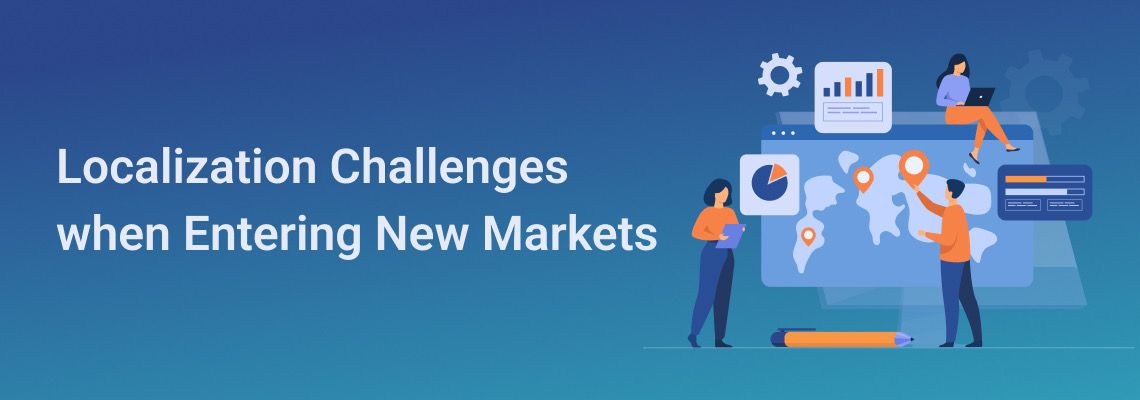

By Alan G
Feb 3, 2022
Localization Challenges when Entering New Markets
We’ve often talked about how beneficial localization is, especially when compared to simple translation. It offers a more encompassing solution that tackles problems that translation doesn’t have the answer to. However, localization is anything but straight-forward. It is a complex process that takes many different factors into account. Cultural sensitivity, money management, and design choices are just some of the aspects you have to be wary of when strategizing your localization. Lucky for you, we’ve got all the necessary answers to these most common localization challenges!
Design Issues
One of the most frequent problems businesses face when attempting to localize their material is design issues. You may have perfected your brand’s look, but you’ve only taken into account how it would look like in one language. That sleek, symmetrical web design with the perfect character count is going to inevitably change when localized to another language. Let’s not forget that not all languages use the Latin script. Editing your source material in order to make sure it maintains your necessary design of choice will require people knowledgeable in formatting. There are certain questions that you have to ask yourself before beginning the process of design localization. Is your business capable of handling different language formats? Is your website/mobile application equipped to handle accents and non-Latin script? Will it be able to handle unfamiliar text such as the Japanese Kanji or the Hindi Devanagari script? Sizing and text issues are expected, which is why your localization agency should be equipped with not just translators, but web design experts as well.
You might have to fine-tune your brand identity to match cultural sensitivities
It’s become a rarity to find a brand without a clear identity. No matter what your product is, every successful brand has a way of communicating with its target audience. Traditionally, we’ve seen Western brands open up and take on a relatable tone, speaking to their clients in the same way you would expect to talk to a friend. It works in countries like the USA and Canada where people are receptive to that sort of communication. They don’t want to feel like they’re talking to a huge conglomerate, devoid of any human personality. However, that’s not the case everywhere. For example, respect for the elderly in China is non-negotiable. There is even a legal responsibility for family members to take care of their elderly or face life in prison. An elderly Chinese man demands respect, and cannot be spoken to in the same way you would speak to a teenager. “What’s up, old man!” would absolutely not work in any advertising or marketing model directed at the elderly Asians. Fine-tuning your brand to appeal to all cultures accordingly might seem like a daunting task at first. You may have fears that your brand would lose all its originality and distort your identity in the process. Your localization agency needs to have multicultural individuals who have the necessary experience in dealing with ethnic and religious nuances that your agency might not have itself. With over 150 translators hailing from around the world, fluent in 50 languages, we know how to adapt to multicultural demands.
Translation Typos and Mistakes
Let’s step away from the intricate and go back to basics. Cultural understanding is important, design compatibility is a must. However, neither of those factors mean much if you mess up the basics. Localization is the natural evolution of basic translation, although it still remains translation at its core. All your hard advertising and marketing work can be undone with a few misspellings and out of place words. As a brand, you have a responsibility to deliver an impeccable language level, no matter how formal or informal your communication style is. Grammar, vocabulary, and syntax are fundamental factors to take into account that can make or break your content. Not everybody has the linguistic know-how for perfect writing, let alone in many different languages! Your localization agency shouldn’t just have multilingual speakers, but excellent writers as well.
Communication Breakdown!
When dealing with localization projects, things may get tricky for your business, your client, and your agency. It’s not as simple as “go ahead and do the job and call me when you’re done”. In order for specific needs to be met, everybody has to be on the same page. This requires an active line of communication between agency and business. You know your brand better than anyone else. You have built it from scratch and know the ins and outs of your identity. With that knowledge in your back pocket, it would be wise to keep an open line of communication with your localization agency in case any questions or suggestions arise. It saves both time and money to have communication software available during convenient hours in order to minimize delays on project return times and mistakes that could have been cleared up earlier. The evolution of technology has been rampant and it has made our lives a whole lot easier. Time to take advantage of it!
Time and Time Again
Some people say time is relative, others claim time is a flat circle. Either way, time is of the essence. We’ve spoken about the issues that may arise when accounting for different language formats, but there’s one key element we haven’t spoken about yet. Time zones. Time zones are fickle. They vary vastly from continent and country, and some nations are even debating whether concepts like Daylight Savings are even worth it in the modern age. Daylight Savings started as a mechanism to help farmers achieve more sunlight for their crops, but in 2022, the question still remains as to whether it’s still necessary. Accounting for time zone differences is a crucial part of the localization process. You might think that seeing the wrong time displayed on a website would be an irrelevant minor detail, but minor details go a long way in building trust and consumer revisits to your website. Countries like Venezuela have actually changed their time zone in the last decade, and some countries like China only have one time zone despite spanning a huge chunk of the globe. Your localization agency needs to be familiar with the time zone allocations of each and every target market you plan on accommodating. Thankfully, our timekeepers at GTH are more than familiar with how the clock ticks.
GTH has been localizing content for over a decade now. We have experience working in sectors that vary from e-Commerce, iGaming, Software & IT, e-Learning, and even Digital Media. With a team of polyglots fluent in over 50 languages, each hailing from their own native ethnicity and nationality, we’re more than well-equipped to handle whatever localization needs you throw at us. If you’re looking for a hands-on team of experts who deliver quality content while maintaining your digital brand, look no further. You’re in capable hands. Ready to get started?



 English
English Greek
Greek +44 730 8577 353
+44 730 8577 353 +357 25 55 42 10
+357 25 55 42 10